- Top
- Eating
- full-course-meal
- history and meaning of kaiseki-ryori
History, meaning and definition of Kaiseki-ryori(cha-kaiseki)
Japanese tea ceremony sprit dwell within Kaiseki-ryori!
Kaiseki-ryori(懐石料理) also called Kaiseki dining is based on tea ceremony. It is a Japanese traditional cuisine, and its origin is Daikyo-ryori(see The origin and history of five Japanese traditional cuisine). It is also called Cha-Kaiseki because there is another Kaiseki-ryori(会席料理). Cha maens "tea" in Japanese.
Kaiseki-ryori was established by Sen-no-Rikyu who was a master and votary of tea cremony from Sengoku period(1467-1568) to Azuchi-momoyama period(1573-1603). Therefore, Kaiseki-ryori has the spirits of tea ceremony, Wabi-sabi, seasonality, the original characteristic of food and hospitality. It consists a rice, miso soup and three side dishes which are vinegared fish salad, boiled vegetables and roasted fish or meat. However, other dishes are added to Kaiseki-ryori in Japanese restaurants nowadays, the delicacies of the seasons, confectionery and more.
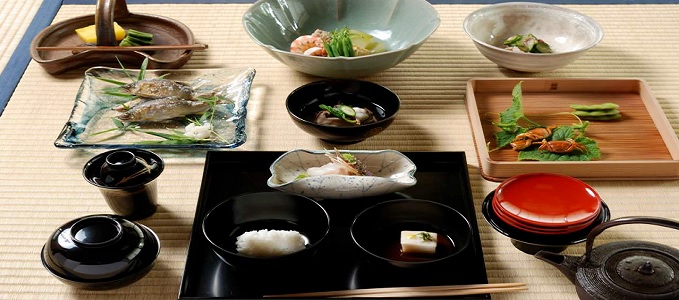
A tea ceremony in the past was held in a certain season and time, winter's early morning tea ceremony, summer's morning tea ceremony, afternoon tea ceremony, winter's late night tea ceremony and more. Kaiseki-ryori was served differently depending on the season and time. Nowadays, Japanese restaurants serve it in the same way.
Kaiseki-ryori(懐石料理)'s "Kaiseki" means to appease one's hunger and warm oneself, and "ryori" means a dish. The origin of it is that Zen Buddhist priests stayed their stomach by hugging a hot stone. Because they had a dish only in the morning for a day, they were hungry and their temperature fell in the night. Sen-no-Rikyu tied up Zen Buddhism and tea ceremony, and established Kaiseki-ryori in Azuchi-momoyama period(1573-1603).
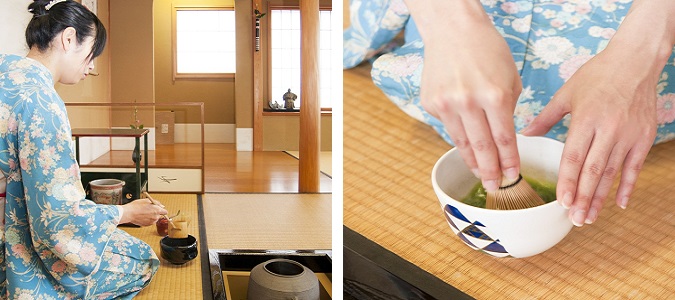
Nowadays, Kaiseki-ryori is known as a high class Japanese traditonal dish(Washoku). It's tea ceremony aspect wanes a littele though many Japanese restaurants serve it. It closes with another Kaiseki-ryori(会席料理). Therefore, Kaiseki-ryori emphasized on tea ceremony is also called Cha-kaiseki. Cha-kaiseki is popular among Japanese who like a tea ceremony.
Kaiseki-ryori consists rice, miso soup and three dishes in the past. Nowadays, it consits about rice, miso soup and about eight dishes. Many Japanese restaurants serve alcoholic drinks instead of tea.
- 1.Rice:
- boiled rice which is extremely small
- 2.Miso Soup:
- white miso in the west, blended miso in the east
- 3.Mukozuke:
- raw fish or vinegared fish sandwiched between sheets of kelp
- 4.Wanmori:
- clear soup with some ingredients, also called Suimono
- 5.Yakimono:
- roasted fish or meat
- 6.Shiizakana:
- boiled dish, vegetables, masrooms, tofu(bean curd) and fish or meat
- 7.Kozuimono:
- small soup to refresh one's taste
- 8.Hassun:
- delicacies for alcoholic drinks
- 9.Yuto:
- fried rice soaked in soup
- 10.Konomono:
- Japanese pickles
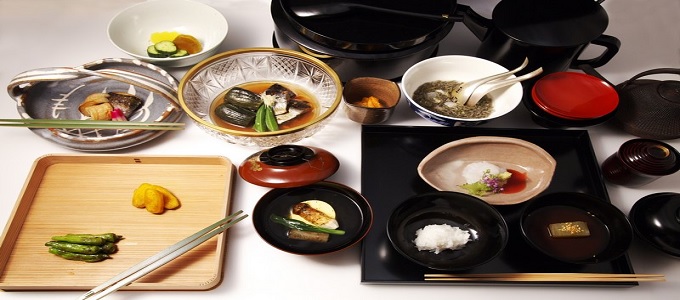
Kaiseki-ryori varies by resutaurants and course though above menu is standard. Some restaurants removes some dishes, especially from Shiizakana to Kounomono, depending on course. On the other hand, some restaurants add some dish to above menu. Cha-Kaiseki has a tea at last in above menu.
There are many restaurants to eat Kaiseki-ryori in Japan, most of them are called "Ryotei" or "Kappo". Ryotei is an exclusive Japanese restaurant. It serves Kaiseki-ryori in a Japanese style reception room with straw mat called tatami on the floor. In some Ryotei, customers can call Geisha or Maiko who entertains them by playing music, dancing, serving drinks with talking or playing Japanese traditional games with them. Many Ryotei which have a long history do not accept unfamiliar customers, only accept new customers through introdutions.
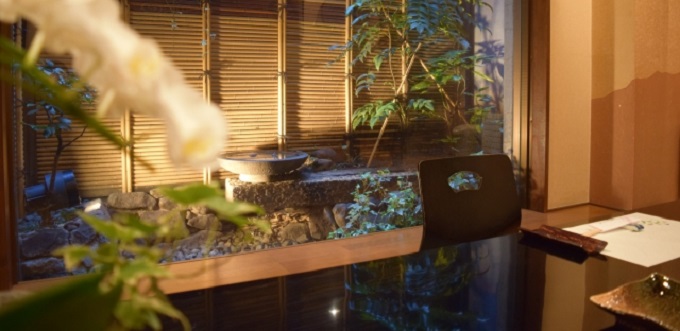
"Kappo" serves Kaiseki-ryori in a counter table. Some Kappo restaurants serve not only full course meal but also individual dishes(à la carte). In addition, some of them do not have a waitress though Ryotei has waitress called Nakai. Customers of Kappo are closer to the chefs than Ryotei, and can enjoy Kaiseki-ryori cheaper than Ryotei. However, some Kappo serve not Kaiseki-ryori but Japanese home cuisine. If you go there to eat Kaiseki-ryori, you should confirm that before you go.
By the way, there is "Shokado-bento" which is known as informal Kaiseki-ryori. It is a lunch box packed with small rice balls and other foods, Mukozuke(raw fish or venegared fish), Yakimono(roasted fish or meat) and Shiizakana(boiled dish) and more except soup. It is sold not only in Kappo but also in some department store or terminal train stations or union stations like Tokyo station.
If you travel Japan, you can experience Japanese culture through Kaiseki-ryori. Note that a reservation is necessary for Kappo and Ryotei restaurants.
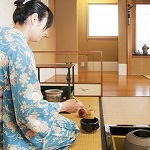 Cha-kaiseki
Cha-kaiseki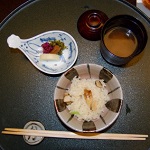 Kaiseki-ryori
Kaiseki-ryori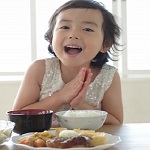 Shojin-ryori
Shojin-ryori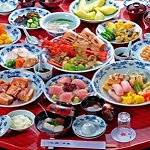 Shippoku-ryori
Shippoku-ryori